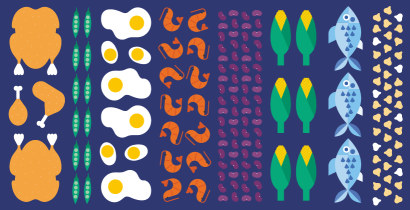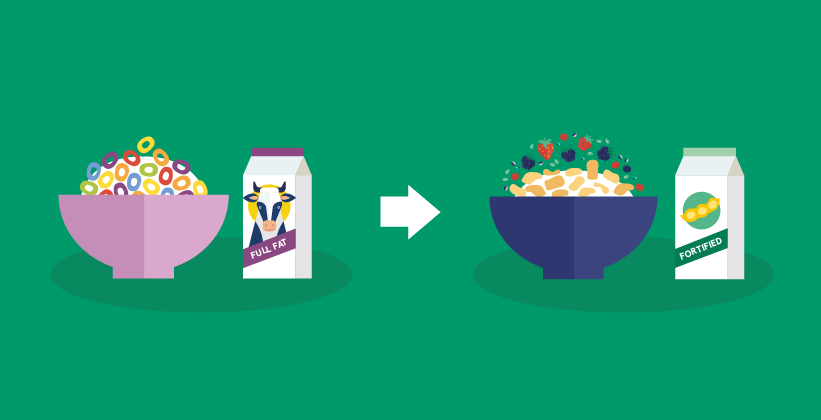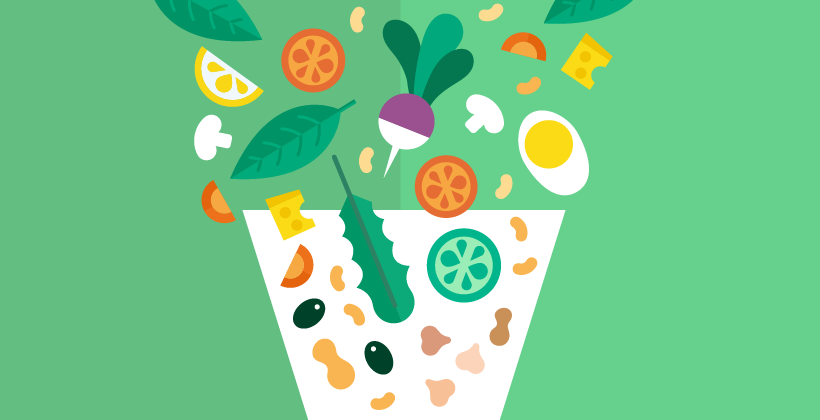Plant-based protein: all you need to know to get enough of it
Last Updated : 05 January 2022You may have heard that plant-based diets fall short on protein, yet you might get surprised at the variety of plant foods that can help you meet your protein needs. If you still turn up your nose at the idea of swapping meat for pulses – or if you’d like to include more plant-based meals in your diet but just don’t know where to start – this article might help you take a step further.
Check out the EUFIC guide on “Cooking plant-based: How to get enough protein” for more.

Why choose more plant-based proteins?
Shifting dietary patterns to reduce meat consumption and include more protein plants can bring great benefits to both our health and the planet.
Besides having a lower environmental footprint, whole plant foods, such as pulses, legumes and vegetables tend to provide more fibre and antioxidants while being lower in saturated fat, sodium and cholesterol compared to animal proteins such as meat and dairy. This is part of the reason why research suggests that people who eat more plant-based tend to have a lower risk of some diseases such as heart disease and type 2 diabetes.1
You can read more about the benefits of plant-based diets here.
Trying to eat more plant-based can also make us more creative in the kitchen and reach for foods or ingredients that otherwise we would not consider. This will not only introduce us to a surprising new range of flavours and textures, but also expand the range of beneficial nutrients and compounds that we get from our diets!
How much protein do you need?
The amount of protein we need daily depends on our weight. On average, a healthy adult should eat at least 0.8 grams of protein per kilogram of weight.2 As an example, if someone weights 60 kg, this means they should aim for a minimum of 48 g of protein a day (60 kg x 0.8 g = 48 g).
Keep in mind that this a general recommendation. Requirements vary on an individual basis and you may need more of it depending on your level of physical activity, health status or if you’re pregnant/breastfeeding.
So if you’re planning on changing your diet to eat more (or exclusively) plant-based, the best way to ensure you’re meeting your nutritional needs is to consult a registered dietitian or nutritionist.
Plant-based vs animal-based protein
A plant-based diet can provide enough protein; however, it might take some planning. In current European food cultures, meat and animal products are often the main protein sources in the diet, so when choosing to replace them, you need to ensure you pick protein-rich plants and not just any vegetable or a simple salad.
But when it comes to protein it’s not only about the quantity but also the quality.
The quality of proteins is defined by the amount of essential amino acids they provide and how well our bodies can digest them (break down and absorb them). Amino acids are the building blocks of proteins. While our body can produce some of them on its own, there are nine – known as essential amino acids - that we must get exclusively from the diet. These play a particular important role in our muscle health and tend to be most conveniently provided by animal products (such as fish, meat, eggs and dairy), which is why they need to be taken into particular consideration in plant-based diets.3
The quality of plant-proteins varies but it is usually lower than that of meat and dairy. This is because not all plant proteins provide sufficient amounts of all the essential amino acids and some also contain specific components (like phytates, tannins and saponins) that can interfere with protein absorption.4
But this doesn’t mean that a vegan diet can’t provide you with enough protein and essential amino acids. Some plants do contain high quality protein (such as soy), and including a variety of protein sources (like pulses, whole grains, nuts, seeds and soy products) throughout the day will allow you to combine and complement the different amino acids in the right balance.4, 5
You can learn more about proteins and their function in our bodies here.
Rich plant-based sources of protein
Getting enough quality protein from plants is possible and there are plenty of options to include in our diet. The key is to make sure to combine and vary different sources throughout the day.
Besides pulses and whole grains, meat substitutes can be used to add variety to your vegetarian meals. These products resemble meat in colour, texture or taste but are made from plant-based sources of protein. A few examples include soy-based meat substitutes (like tofu, tempeh and texturized vegetable protein); seitan (made from wheat protein) and mycoprotein (made from the fungus Fusarium venenatum).
However, keep in mind some products made from meat substitutes such as sausages or burgers, may be higher in sodium (salt) and saturated fats and provide less health promoting compounds such as fibre and antioxidants. Therefore, they should be eaten in moderation and as part of a healthy and balanced diet. When opting for these foods, make sure to read the labels and look for more nutritionally balanced options.
Plant-based alternatives to milk, yoghurt and cheese are also popular products among people trying to reduce animal product consumption. However, keep in mind that apart from soy products; cereal- or nut- based dairy alternatives (such as oat, almond and rice milk), as well as vegan cheese, currently do not provide enough protein to be considered a good source of protein.
Below we show you a few examples of how much protein you can get from 100 grams of plant-based foods.
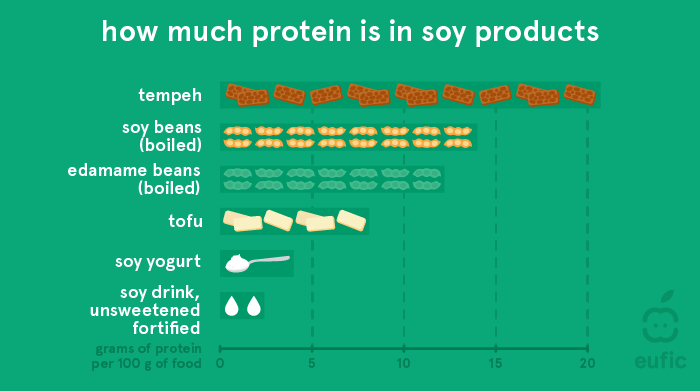
Fig. 1 – Protein content in soy products: tempeh, soy beans (boiled), edamame beans (boiled), tofu, soy yogurt and soy drink, unsweetened, fortified.6,7
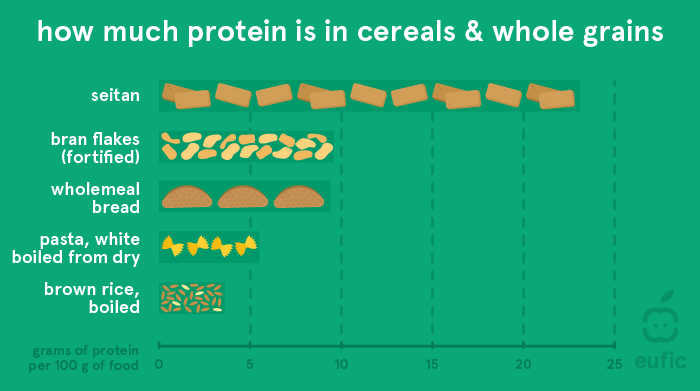
Fig. 2 – Protein content in cereals & whole grains: seitan, bran flakes, wholemeal bread, white pasta (boiled) and brown rice (boiled).6,7
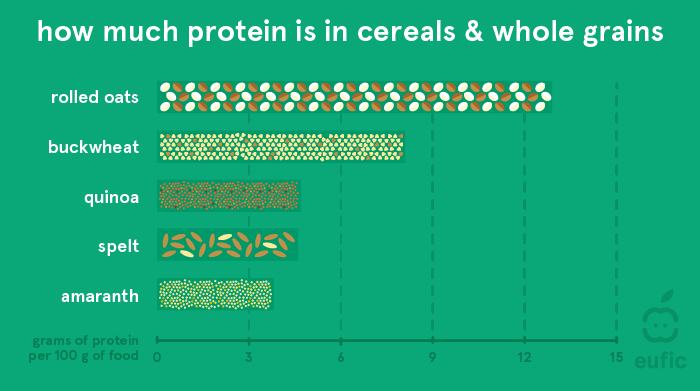
Fig. 3 – Protein content in cereals & whole grains: rolled oats, buckwheat, quinoa, spelt and amaranth.6,7
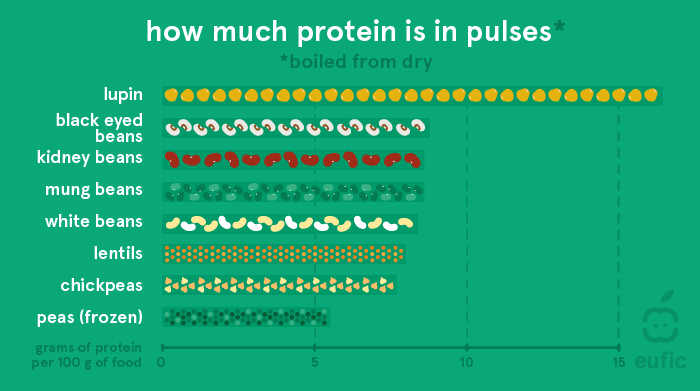
Fig. 4 – Protein content in pulses: lupin, black eyed beans, kidney beans, mung beans, white beans, lentils, chickpeas and peas (frozen).6,7
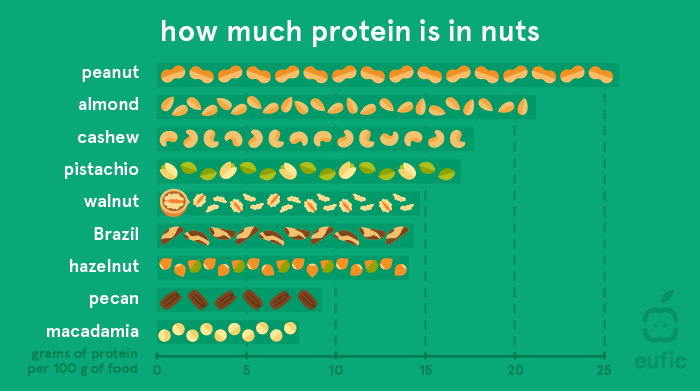
Fig. 5 – Protein content in nuts: peanuts, almonds, cashews, pistachios, walnuts, Brazil nuts, hazelnuts, pecans, macadamia.6,7
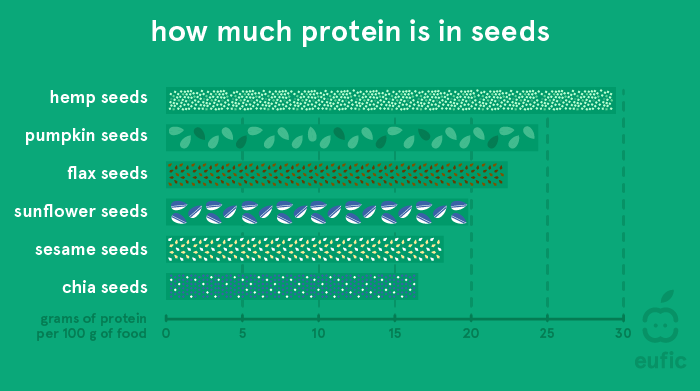
Fig. 6 – Protein content in seeds: hemp seeds, pumpkin seeds, linen seeds, sunflower seeds, sesame seeds, chia seeds.6,7
5 simple tips to make the most out of your plant proteins:
- If you use dry pulses, soak them prior to cooking for a few hours. This will help improve their digestibility. However, avoid using the same water to boil or cook them.
- Include both cereals and legumes regularly: they complement each other in the essential amino acids they provide.
- Pair your plant-based meals with vitamin-C rich foods. This will help increase your iron absorption from pulses, whole grains and other vegetable sources.
- Look for fortified products (such as plant-based alternatives to milk and dairy or cereal-based products) to help increase your intake of B-vitamins, iron, vitamin B12 and calcium.
- Include nuts and seeds in smaller portions. Even if they’re good sources of protein, they’re still relatively high in energy and fats.
How much plant-protein should be in your plate?
Vegan versions of the “healthy plate” model do exist and may help you visualise how much plant proteins you should include in your plate and guide you on how to balance the different food groups in a vegan diet. Keep in mind that recommendations may vary depending on your country’s guidelines, so always make sure to check the advice from your local authorities first.
General guidelines suggest a balanced vegan plate should look like:8
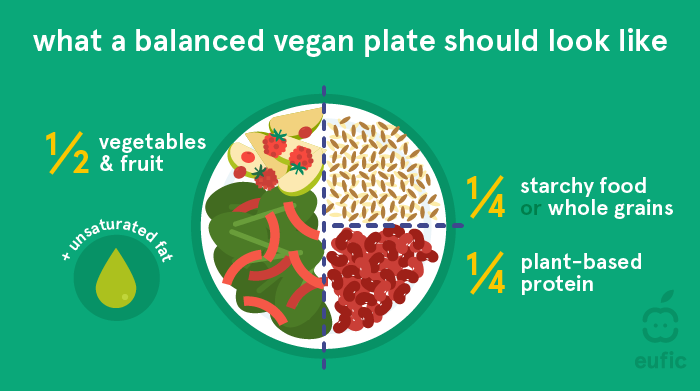
- ½ of fruits & vegetables (ideally, different types and colours)
- ¼ of plant-based proteins (legumes, nuts, seeds, soy-based products)
- ¼ of wholegrain cereals (pasta, rice, wholegrain bread, etc.)
Summary
Changing to a vegetarian diet may increase your risk of lacking certain nutrients (such as iron, calcium, vitamin B12, vitamin D, iodine, zinc and some omega-3 fatty acids) which are significantly provided by fish, meat, dairy and eggs.
As so, depending on the type of diet you follow and to which extent you exclude animal products, your needs regarding plant proteins and other nutrients may look differently. For example, people that regularly include dairy and eggs on their diets may be at lower risk of lacking critical nutrients such as vitamin B12 and calcium, compared to those that fully exclude animal products.
Well-planned vegetarian diets containing a variety of whole plant foods can prevent nutritional deficiencies. At times supplementation may be needed. So, if you’re planning to significantly reduce – or completely exclude – meat and animal products from your diet, do seek professional advice from a registered nutritionist/dietitian to make sure you’re meeting all your nutritional needs.9
References
- Bechthold, A., Boeing, H., et al 2019. Food groups and risk of coronary heart disease, stroke and heart failure: a systematic review and dose-response meta-analysis of prospective studies. Critical reviews in food science and nutrition, 59(7), pp.1071-1090
- EFSA (2012). European Food Safety Authority, Scientific Opinion on Dietary Reference Values for protein. EFSA Journal 2012; 10(2):2557.
- Alcorta, A., Porta, A.,et al. (2021). Foods for Plant-Based Diets: Challenges and Innovations. Foods, 10(2), 293.
- Marinangeli, C., House, J. (2017). Potential impact of the digestible indispensable amino acid score as a measure of protein quality on dietary regulations and health. Nutrition Reviews, 75(8), 658–667.
- Grossmann, L., Weiss, J. (2021). Alternative Protein Sources as Technofunctional Food Ingredients. Supplemental Material: Annu. Rev. Food Sci. Technol. 12.
- Composition of foods integrated dataset (CoFID).
- EuroFIR food composition database.
- The Vegan Eatwell Guide. The Vegan Society. Accessed on 9 Dec. 2021.
- Melina, V., Craig, W. and Levin, S., 2016. Position of the academy of nutrition and dietetics: vegetarian diets. Journal of the Academy of Nutrition and Dietetics, 116(12), pp.1970-1980.
